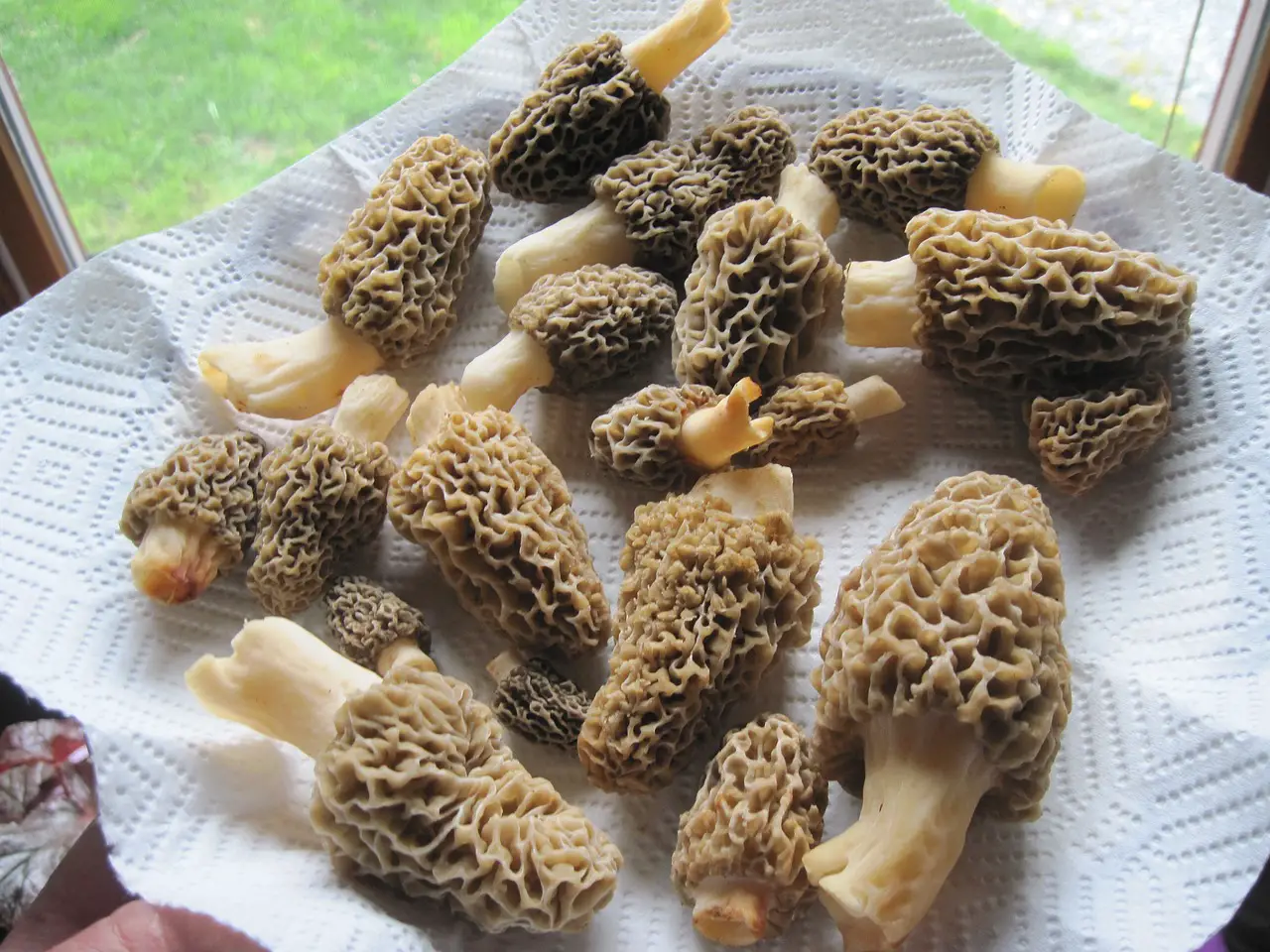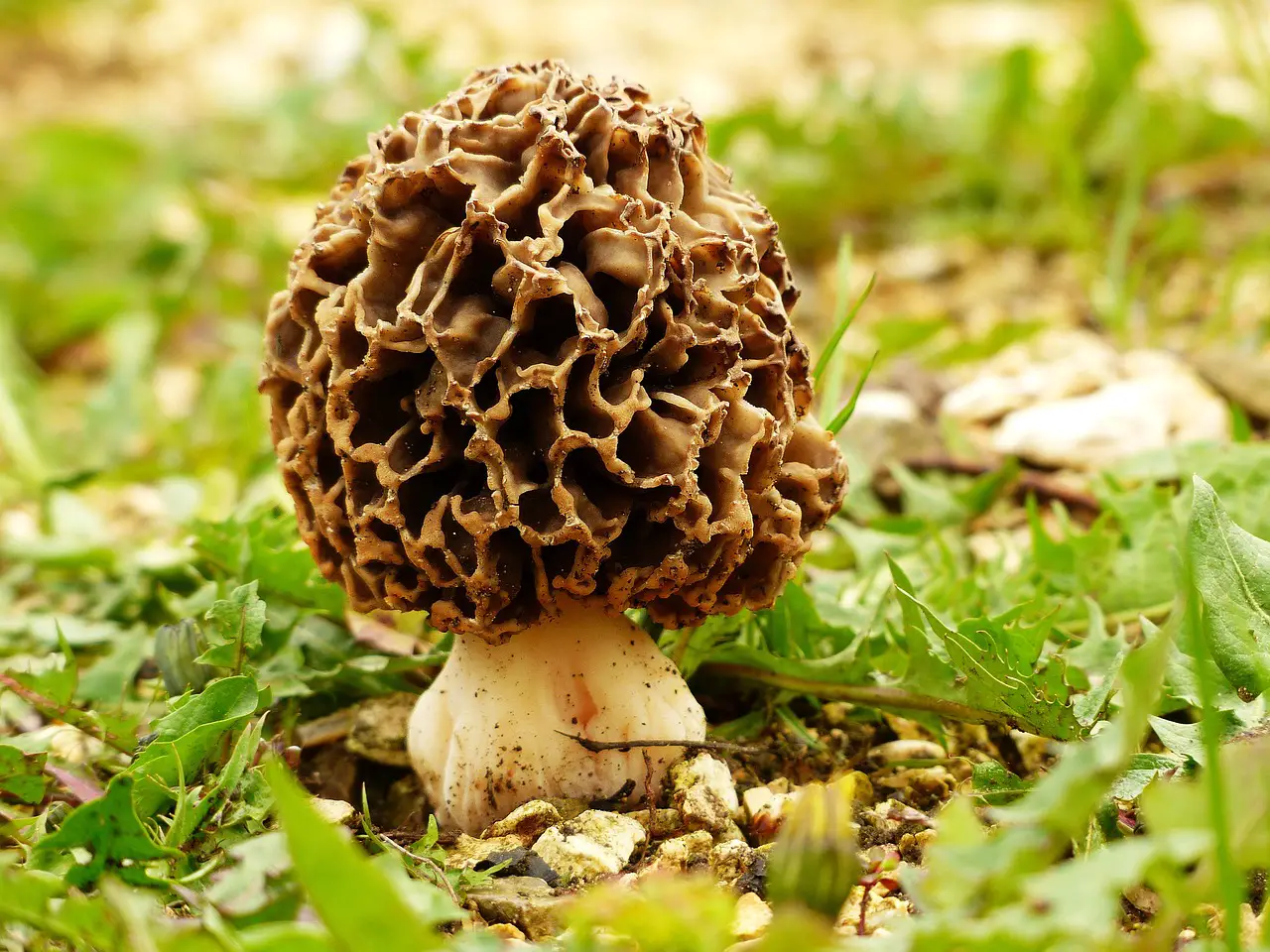If you are a mushroom lover, you know it is important to keep your morel mushrooms fresh. This will help you to enjoy them for a longer time. When fresh morel mushrooms arrive at your home, you’ll want to know how to store them, so they remain delicious and nutritious for as long as possible. There are several ways to keep them fresh without risking dehydration and spoilage.
To store morel mushrooms, wrap them loosely in a damp paper or cloth and place them in a bowl. This is a good way to maintain their freshness for a few days. If you’re storing your morel mushrooms for a long time, it’s best to keep them dry. You can do this in various ways, from using a dehydrator to stringing them up and letting them hang in the sun.

What are Morel Mushrooms?
For their distinctive, nutty, and earthy flavor, morel mushrooms, a species of edible wild fungus, are much sought after. Their unique features include a honeycomb-like, spongy crown and a typically hollow stem. They are highly sought after by mushroom hunters and are prized in many international cuisines. They can be cooked in various ways, such as braising, frying, and sautéing. Morels are a seasonal component that is often found in the spring.
How to Store Morel Mushrooms?
These steps should be followed to store more mushrooms:
- Brush any dirt or debris from the mushrooms gently. They will absorb water and turn mushy if you wash them.
- A paper bag filled with mushrooms should be sealed by folding the top over. The mushrooms will stay fresh, and the extra moisture will be absorbed by doing this.
- The mushrooms can be kept in the bag for up to a week in the fridge. Avoid putting the mushrooms in a plastic bag since it will collect moisture and hasten their spoilage.
Additionally, morel mushrooms can be frozen for later use. To accomplish this, properly clean and dry them, spread them out on a baking sheet, and freeze them until firm. Place the frozen mushrooms in a bag or container and store them in the freezer for up to six months.
You can ensure that your morel mushrooms are preserved correctly and maintain their quality and flavor by following these instructions.
How to Freeze Morel Mushrooms?
How to freeze morel mushrooms is as follows:
- Brush any dirt or debris from the mushrooms gently. They will absorb water and turn mushy if you wash them.
- The mushrooms should be blanched in boiling water for two to three minutes before being immediately moved to an ice bath to stop the cooking.
- With paper towels, pat the mushrooms dry to remove any extra moisture.
- Place the mushrooms on a baking sheet in a single layer, then freeze them for about two hours or until they are fully solid.
- When the mushrooms are frozen, move them to a freezer-safe bag or container, mark them with the date, and put them back in the freezer.
- When ready to use, defrost the mushrooms in the microwave or refrigerator overnight before cooking as usual.
Following these instructions, you can enjoy morel mushrooms for months while preserving their flavor and texture through freezing.
How to Properly Thaw Frozen Morel Mushrooms?
This is how morel mushrooms are defrosted:
- The mushrooms should be removed from the freezer and placed in the refrigerator to thaw overnight.
- You can use the microwave to hasten the thawing process. The mushrooms should be defrosted in the microwave on the defrost setting, stirring every so often, until they are completely thawed.
- The mushrooms can also be thawed by putting them in a colander and running them under cool water for a short while.
Regardless of your method, be sure to cook the mushrooms as soon as they are completely defrosted since if you keep them at room temperature for too long, they will lose their quality and texture.
By carefully thawing the mushrooms, you may preserve their flavor and texture while enjoying their distinct flavor and texture in various meals.
Can Morel Mushrooms be Consumed Raw?
Since morel mushrooms contain trace amounts of hydrazine chemicals, which can upset the stomach if consumed excessively, it is typically not advised to eat them uncooked. These substances can be diminished, and the mushrooms can be safely eaten by sautéing, braising, or boiling them mushrooms.
In addition, many people find the rough, woody feel of uncooked morel mushrooms unappetizing. The texture and flavor of the mushrooms are improved by cooking them.
If you’re unclear whether eating morel mushrooms raw is safe, it’s recommended to err on caution and boil them first.
How to Include Morel Mushrooms in your Diet?
Morel mushrooms are a flexible component that can be used in several cuisines to add depth of flavor and nutrition to your diet. Here are some suggestions for how to cook with morel mushrooms:
- Omelets, frittatas, or scrambled eggs can all be enhanced with sautéed or fried morel mushrooms.
- Morels can be added to soups, stews, or sauces to enhance the richness and depth of flavor.
- They can be roasted or grilled as a side dish or topped for grilled steak or chicken.
- Additionally, morels can be fried in bread crumbs for a crunchy and tasty treat.
- They can be diced and added to quiches, pasta dishes, and risotto for extra texture and flavor.
Dried morels can be reconstituted and added to recipes for a powerful and earthy flavor.
There are numerous tasty and inventive ways to incorporate mushrooms into your diet to enhance flavor and nutrition.
Where to Buy Morel Mushrooms?
Usually available in the spring, morel mushrooms are a seasonal item that can be purchased at farmers’ markets, specialty grocers, and gourmet food stores. Dried morels may be offered all year long in some shops.
Morel mushrooms can be purchased online from specialty food retailers and farmers or foragers, in addition to traditional brick-and-mortar stores.
Find morels that are firm and devoid of squishy or slimy areas when shopping for them. Make sure dried morels have a deep, earthy aroma and are a rich, dark hue when purchasing them.
Remember that fresh morels should be used or preserved within a few days of purchase because they are highly perishable. Call the store in advance to find out if they carry morels if you’re unsure.
What is the Taste of Morel Mushrooms?
The flavor and texture of morel mushrooms are deep, earthy, and nutty, with a hint of meatiness. They are highly valued for their distinctive taste, characterized as somewhat sweet, a little smokey, or even slightly woodsy. Some individuals say the flavor has traces of chestnut or hazelnut.
Cooking brings out the morel flavor, frequently used to give soups, sauces, and other dishes more body and richness. They can be used as a basis for dressings and dips and as a garnish for meats, sautéing, or frying.
Morels are renowned for their adaptability and depth of flavor in gourmet cooking, and their flavor is generally regarded as a true delicacy.
How to Clean the Morel Mushrooms?
Cleaning morel mushrooms is a must before cooking or eating them. How to clean morel mushrooms is as follows:
- Rinse: To get rid of dirt or debris, rinse the morels under cool, running water. Avoid soaking them in water because it could make them saline-logged and spoiled.
- Trim the stem: If the morel’s stem is hard or woody, trim it.
- Brush: Gently remove any remaining dirt or debris from the mushroom’s surface using a soft-bristled brush or a moist cloth.
- Slice: To inspect for insects or other debris inside the morels, cut them in half lengthwise. Remove them with a knife if there are any.
To eliminate extra moisture, pat the morels dry with a fresh cloth or paper towel.
Note: To help remove any remaining dirt or debris, some people soak morels in salt water for a short period before cleaning. However, skipping this step could make the mushrooms become soggy, impacting their flavor and texture.
You may ensure morels are fit for consumption and prepared for use in your cooking by thoroughly cleaning them.
How to Identify Whether Morel Mushroom has Gone Bad?
Here are several warning signs that morel mushrooms are no longer edible and have gone bad:
- Off-odor: Bad morels will smell sour or musty, which is a sure sign that they shouldn’t be consumed.
- The morels are no longer safe to consume if they have a slimy or sticky texture.
- Discoloration: Fresh morels have a honeycomb-like pattern on their surface and range in color from light to dark brown. They ought to be thrown away if they have started to look moldy or have started to get discolored.
- The morels are no longer fit for consumption if they have developed a spongy or squishy texture.
- Insect damage: Morels that show symptoms of insect damage, such as holes, should be thrown away since they could contain dangerous pathogens.
It’s preferable to err on caution and toss any morels you are unsure about as being fresh. To avoid rotting and guarantee their suitability for consumption, it’s crucial to store mushrooms carefully.
What are the Adverse Effects of Consuming Spoiled Morel Mushrooms?
Food poisoning, which can result in a variety of symptoms like nausea, vomiting, diarrhea, stomach discomfort, and fever, can be brought on by ingesting rotting morel mushrooms. Food poisoning from rotting mushrooms can sometimes result in dehydration and electrolyte imbalances, which can be harmful and even fatal, especially for small children, older adults, and people with compromised immune systems.
Consuming spoilt mushrooms can also result in toxic bacteria, fungi, or other organisms in the body, which can hurt one’s health.
Get medical help as soon as possible if you feel sick after eating more mushrooms. Mushrooms should always be stored correctly and checked for symptoms of rotting before consumption to avoid food poisoning. In cases of uncertainty, it is advisable to be safe and toss the mushrooms.
The delicious edible fungus known as morels (Morchella spp.) has substantial scientific and economic importance. However, in China’s primary morel farming region, white mold disease, brought on by Paecilomyces penicillatus, can lower morel yield by as much as 80%. P. penicillatus belongs to the family Hypocreales and is connected to the mycoparasitic Hypocreaceae, which comprises numerous species, according to phylogenetic analyses of single-copy orthologous genes. The precise phylogenetic position of P. penicillatus within the polyphyletic genus Paecilomyces is yet unknown. Here, we present the first single-molecule real-time (SMRT) sequencing platform-generated high-quality genome sequence of P. penicillatus. P. penicillatus’s assembled draught genome was 40.2 Mb in size, with an N50 value of 2.6 Mb, and encoded 9454 genes.
Conclusion
Frozen morel mushrooms can be a great way to keep them fresh for up to six months. But it is important to note that freezing morels can cause dehydration and cell damage, which means they will lose their texture and flavor.
You can also clean your morels before storing them. You can soak them in salt water overnight or sprinkle them with salt and let them sit for a few hours. Both of these methods work well for preserving morels. However, they may not be as good as fresh morels when ready to use in a recipe. Another option for storing dried morels is to make a broth or stock from the liquid they soaked in. This can be a supplemental cooking liquid for grains, soups, or risotto.

